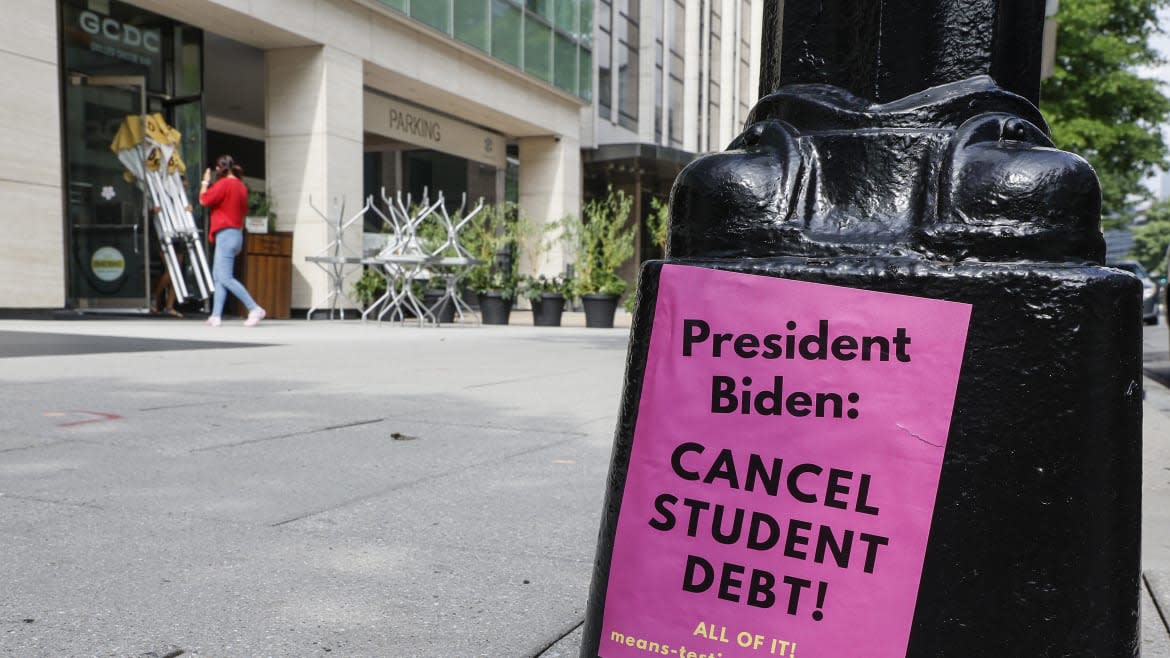Biden Might Have Just Canceled All of Your Student Debt

President Joe Biden has finally revealed his plan to forgive as much as $20,000 in student loan debt for most of the 47 million Americans with federal student loans, canceling more than $300 billion in debt used to finance higher education.
“I made a commitment that we provide student debt relief, and I’m honoring that commitment today,” Biden said in remarks delivered in the Roosevelt Room of the White House.
Under the plan, borrowers who paid for higher education with Pell Grants, provided for students who demonstrate exceptional financial need, will be forgiven $20,000. Borrowers who received other forms of federal student loans will be forgiven $10,000. Both debt cancellations apply only to borrowers who earned less than $125,000 per year in 2020 or 2021, or $250,000 if they are part of a household. Current students, as well as former students, are eligible for debt forgiveness.
The plan also caps undergraduate loan payments at 5 percent of a borrower’s monthly income, cutting the cap in half.
In a briefing ahead of Biden’s remarks, a senior administration official told reporters that roughly 43 million will be eligible for debt forgiveness and that 20 million Americans will have their student loan debt “completely canceled.” The administration official also noted that 60 percent of borrowers obtained loans through Pell Grants, making the majority of eligible loan recipients eligible for up to $20,000 in canceled debt.
“Ninety-five percent of borrowers can benefit from these actions,” Biden said, adding that 45 percent of borrowers will have their student loan debt fully canceled.
“That’s 20 million people who can start getting on with their lives,” Biden said.
The details of Biden’s policy come after months of delays in a long-promised plan to wipe out some of the combined $1.6 trillion in student loan debt owed to the federal government, and only one week before a pause on loan payments instituted at the start of the coronavirus pandemic was set to expire. Student loan debt, which cannot be waived in bankruptcy, has ballooned in recent decades as the cost of higher education has tripled over the last 40 years, even accounting for inflation. Roughly one-third of Americans with federal student loan debt owe less than $10,000, and more than half owe less than $20,000.
Tens of Thousands Could Have Debt Erased as Part of Student Loan Forgiveness Program Overhaul
Biden also announced yet another extension of the repayment holiday. Student loan payments are now set to restart on January 1, 2023, which the administration called the “final” extension.
The order largely—but not entirely—comports with Biden’s campaign promise to “make sure that everybody in this generation gets $10,000 knocked off of their student debt.” Since taking office, the administration has already wiped billions in debt from the federal government’s books, including for students who were defrauded by for-profit colleges, whose schools closed while they were still enrolled, or for graduates with permanent disabilities that prevent them from working.
But Biden’s debt forgiveness plan still falls far short of what many fellow Democrats had hoped for. Congressional allies ranging from Rep. Pramila Jayapal (D-WA), chair of the Congressional Progressive Caucus, to Majority Leader Chuck Schumer (D-NY) spent months pushing Biden to cancel $50,000 in student loan debt, without means-testing requirements that prevent borrowers with higher incomes from having their debt forgiven.
Republicans, too, are almost entirely opposed to the plan, claiming that the forgiveness of hundreds of billions of dollars in debt will further exacerbate high inflation and would benefit only higher-earning college graduates instead of the working class. Roughly 60 percent of Americans have at least partially attended college, but more than half of student loan debt is held by people who went to grad school.
The administration official pushed back on the accusation that the plan will disproportionately benefit well-off Americans, calling the plan “highly progressive.”
“Nearly 90 percent of relief dollars will go to those earning less than $75,000 a year, and no one in the top 5 percent of incomes in America will get a single dollar of relief,” the official said.
Some allied groups have already vowed to file lawsuits challenging Biden’s executive authority to cancel student loan debt—an issue that fellow Democrats, including House Speaker Nancy Pelosi, have raised in the past.
“People think that the president of the United States has the power for debt forgiveness. He does not. He can postpone, he can delay, but he does not have that power,” Pelosi said at a press briefing in July 2021, elaborating that only Congress had the ability to cancel student loan debt. “That’s not even a discussion.”
But Congress has provided some of the mechanisms for Biden to pursue his debt-forgiveness plan, including a stipulation of the American Rescue Plan that bars student loan forgiveness from being considered taxable income by the Internal Revenue Service.
On Sunday, Education Secretary Miguel Cardona said that the administration has been focused “from Day One” on protecting student borrowers, calling the approval of roughly $32 billion in student loans since Biden took office “an important issue across the country.”
“We’ve been talking daily about this,” Cardona told NBC in an interview ahead of Biden’s announcement.
Get the Daily Beast's biggest scoops and scandals delivered right to your inbox. Sign up now.
Stay informed and gain unlimited access to the Daily Beast's unmatched reporting. Subscribe now.


